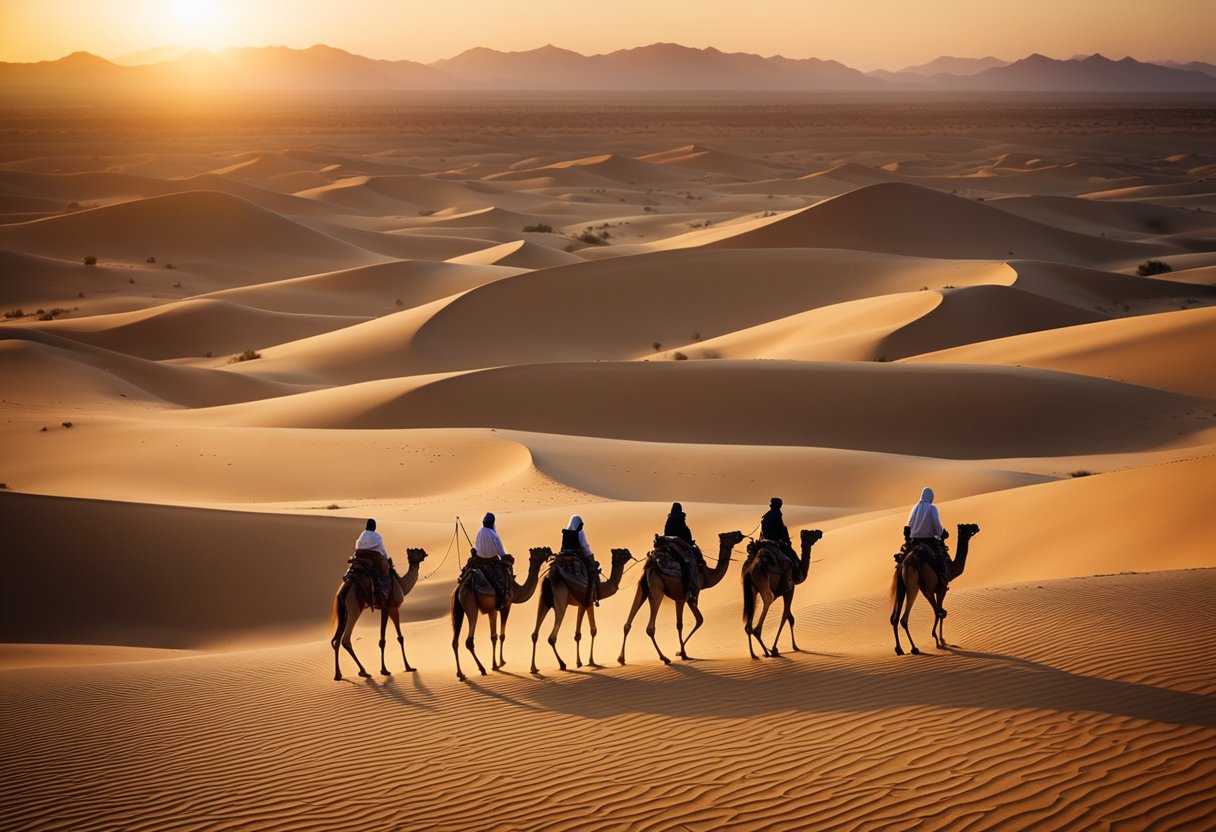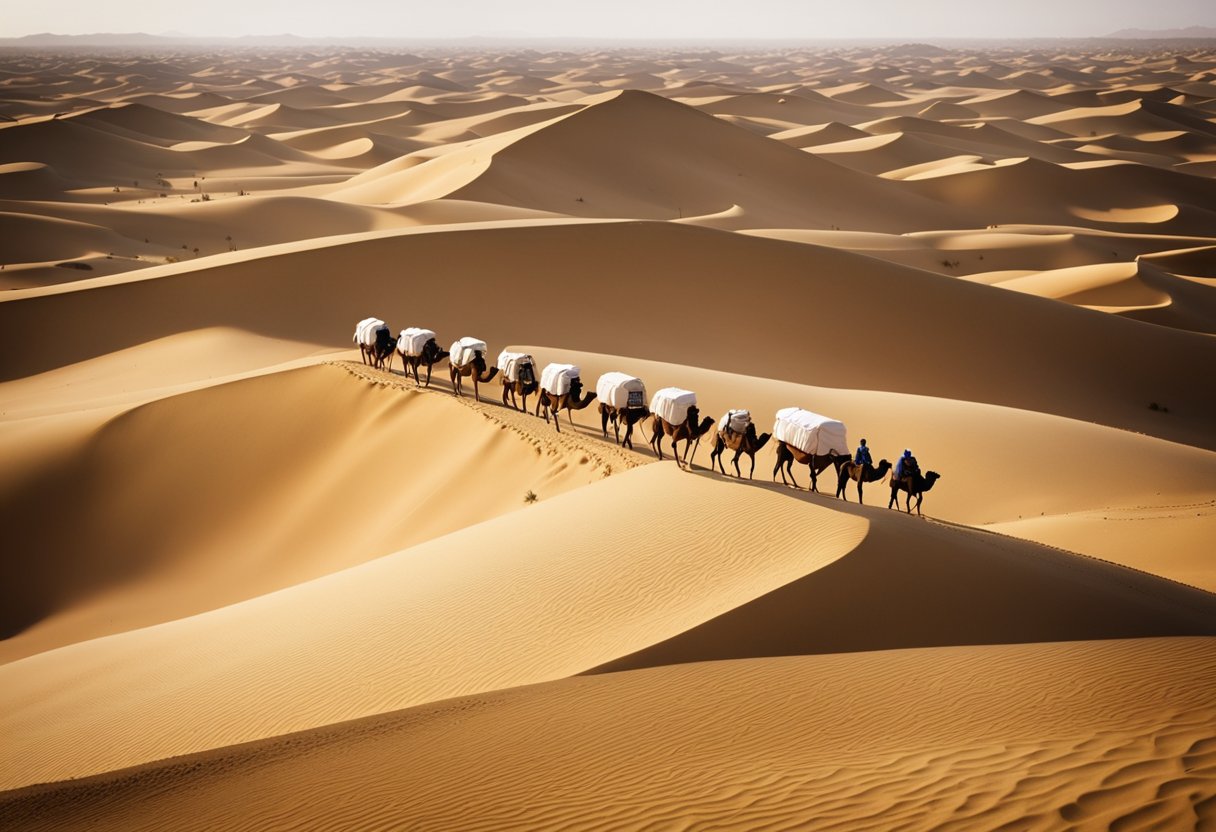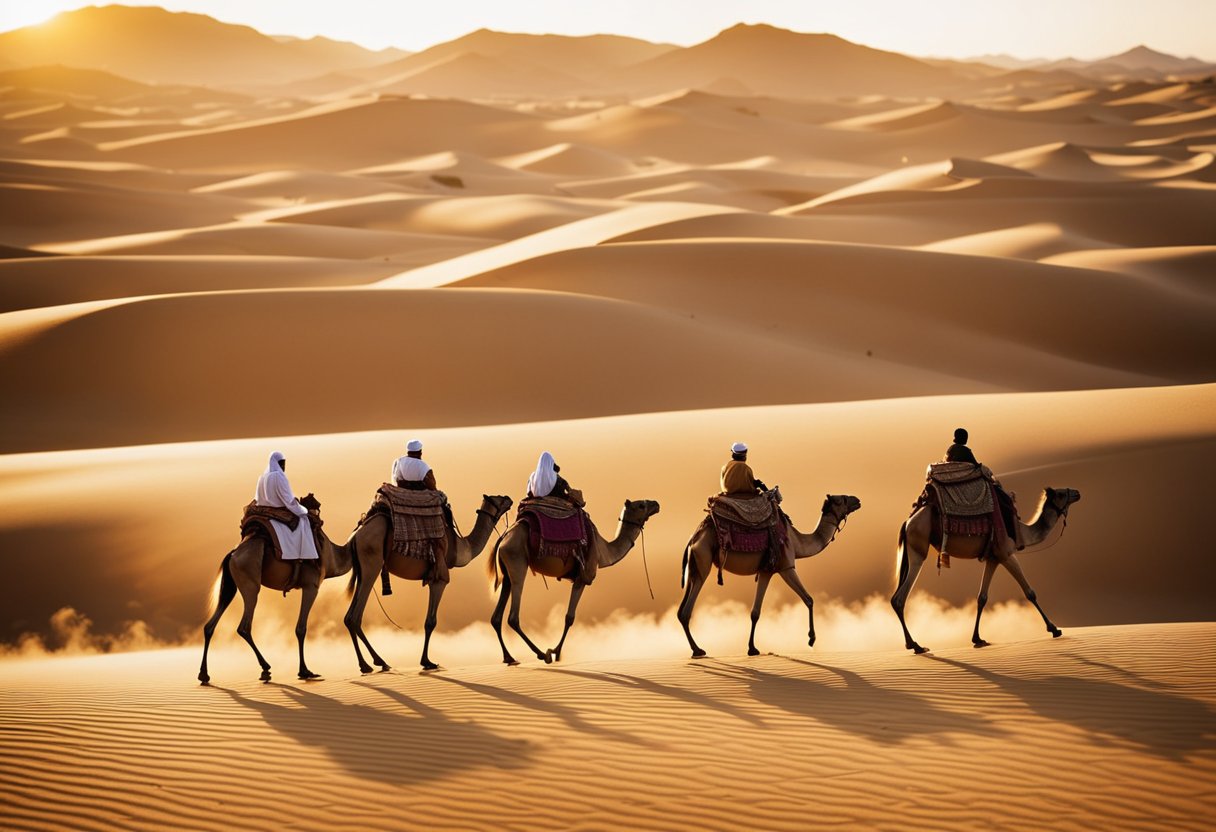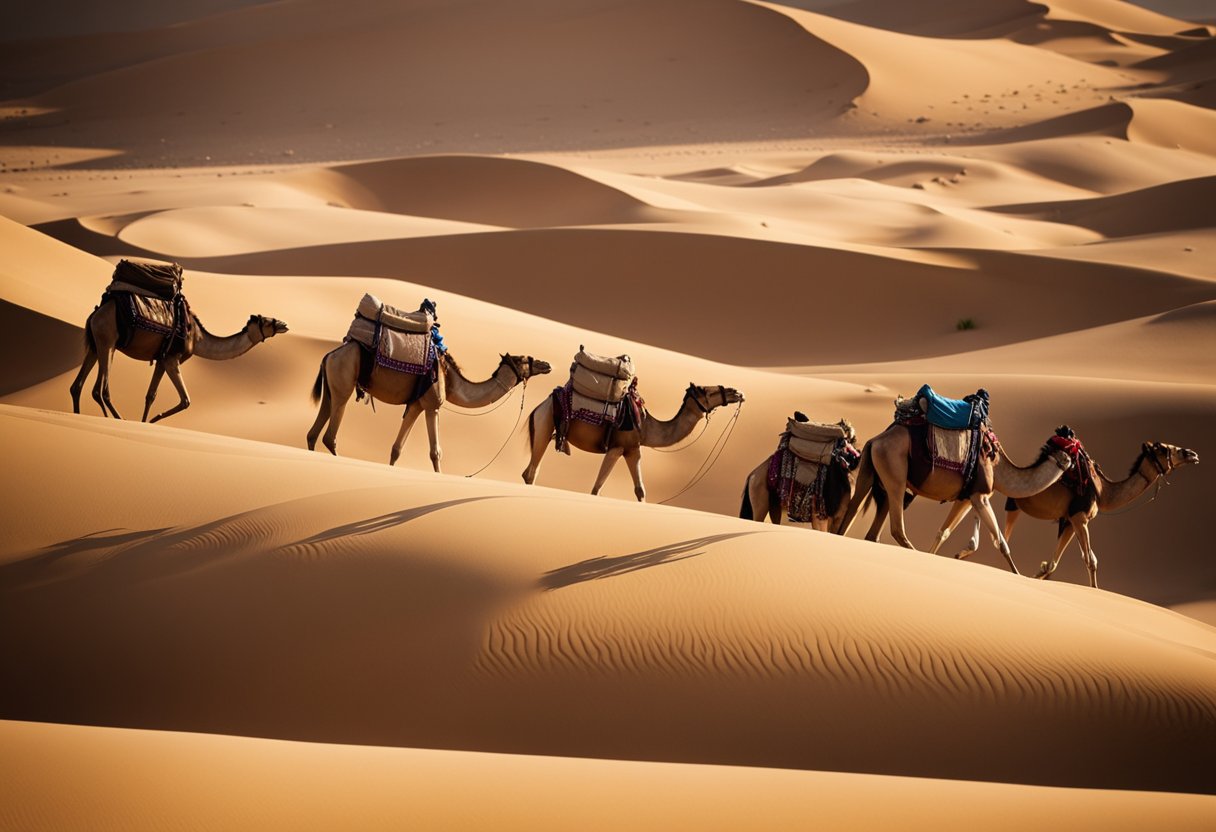The Trans-Saharan Trade Routes: Uncovering the Riches and Tales of Desert Commerce

Updated On: April 20, 2024 by Marwa Alaa
The Trans-Saharan trade routes were a network of paths crisscrossing the daunting expanse of the Sahara Desert, serving as a conduit for the exchange of goods, cultures, and ideas. These routes were the veins through which the heart of Africa’s economy pulsed, connecting the Mediterranean with the Sahel and sub-Saharan regions. They facilitated the movement of precious resources like gold and salt, which were as valuable as currency and essential for preserving food and maintaining health.

Central to these trade pathways was the camel, introduced around the third century AD, which revolutionised transport across the desert’s harsh terrain. The resilience and endurance of these animals made it possible to carry heavy loads over long distances, sustaining the flow of wealth and enabling the rise of empires such as Ghana, Mali, and Songhai. Alongside commodities, the routes also facilitated the spread of ideas, technologies, and religions, notably Islam, which shaped the cultural and intellectual landscapes of West African societies.
Historical Overview of Trans-Saharan Trade
Trans-Saharan trade has been pivotal in shaping the socio-economic landscape of Africa. By the 8th century, a burgeoning network of trade routes had solidified, driven in part by the introduction of the camel, which Berbers adeptly utilised. These caravans journeyed across the Sahara Desert, enduring its unforgiving expanse to facilitate exchange between North Africa and West Africa.
Key commodities native to the region, notably gold and salt, were crucial to the economies bridging the Sahara. West Africa was abundant in gold, particularly within the influential Ghana Empire, while salt, essential for preserving food, was more readily available in the North. The Mali and Songhai empires later succeeded Ghana, further entrenching the trans-Saharan trade.
Arab merchants played a significant role in this exchange, introducing not only goods but also Islam, which gradually integrated into African societies. This cultural infusion added a rich layer of stories and ideas to the physical trade, contributing to a diverse cultural and religious tapestry that is still evident today.
Our understanding of trans-Saharan trade routes is greatly enhanced by various historical accounts, which detail the arduous treks made by the caravans through the desert. Not just a passage for goods, these routes were conduits for stories and knowledge, creating a legacy that transcends mere commerce.
By fostering ties between continents and cultures, the trade across the Sahara had overarching impacts on the political and cultural realms within Africa, leaving an indelible mark on the world’s historical narrative.
Geographical Significance
In this section, we explore the imposing Sahara Desert and the oases that dot this arid landscape, both harbingers of life and pillars of the ancient Trans-Saharan trade networks.
Physical Geography of the Sahara
The Sahara, the largest hot desert in the world, presents a formidable barrier of sand seas, gravel plains, rugged mountains, and vast plateaus. Stretching approximately 9.2 million square kilometres, the Sahara Desert encompasses several modern-day African countries, extending from the Red Sea in the east to the Atlantic Ocean in the west. The desert’s climate is characterized by scarce rainfall, extreme temperature fluctuations, and harsh living conditions. Despite its predominantly arid environment, the Sahara’s fringe regions, like the Niger River Basin to the south, offer more hospitable climates and fertile lands.
Oases: Lifelines in the Desert
Scattered throughout the central Sahara are oases, pivotal in sustaining life and facilitating trade across this blistering landscape. These verdant pockets, sustained by water sources such as natural springs or underground aquifers, interrupt the desert’s monotony and have historically served as crucial waypoints for traders. The presence of oases not only provided respite and replenishment of vital resources like water but also acted as melting pots of cultural interchange among the desert’s travellers.
Economic Activities and Resources
The trans-Saharan trade routes were pivotal to economic activities in Western and Northern Africa, centred around the exploitation and exchange of treasured commodities like gold and salt. Below we unravel this intricate trading network that powered ancient economies.
The Gold Mines
The extraction of gold from the rich veins of Western Africa fuelled the economies of empires and initiated the well-known gold trade. These mines, often comprising simple open pits, yielded significant quantities of gold nuggets, which subsequently formed a crucial part of regional wealth. The AP World History Unit 2.4 Trans-Saharan Trade Routes – Fiveable emphasises the role these precious metals played in bolstering the power and affluence of ruling elites.
Salt Production and Trade
Similarly, vast salt mines in the heart of the Sahara were instrumental. Salt, being essential for the preservation of food and the maintenance of health, was as valued as gold, if not more so. Caravans traversed the harsh desert, bringing salt to trade for other goods, enabling not just economic but also cultural exchanges. Resources detail how salt was transported from places like Taoudenni to trading centres such as Timbuktu and beyond.
Trading Goods and Currency
Aside from gold and salt, a variety of goods served as currency in the trans-Saharan trade. Textiles, copper, and other materials were exchanged, forming a barter system that predated modern monetary systems. Trade routes connected disparate regions, allowing for the exchange not only of goods but also of ideas, technologies, and beliefs. The integration of this network into the broader world economy was facilitated by the trade of such diverse commodities, as outlined by the World History Encyclopedia.
Cultural and Technological Exchanges
The Trans-Saharan trade routes not only facilitated the exchange of commodities but were also vital conduits for cultural and technological innovations. Through the movement of goods, ideas, and people, these routes catalysed the spread of religious beliefs, artistic expressions, and technological advancements.
Religion and the Spread of Islam
The introduction and spread of Islam across the Sahara linked the Islamic world to sub-Saharan Africa. Muslim scholars and traders journeyed across the desert, bearing with them new religious texts and knowledge. The adoption of Islam incorporated vast swathes of the continent into a cosmopolitan religious sphere, fostering a shared culture and a common language—Arabic. Communities on trade routes often became vibrant centres of Islamic learning, establishing lasting traditions of scholarship.
Art and Learning
Art and learning thrived along the Trans-Saharan passages, with the creation of religious and educational centres. This scholarly activity enriched local cultures, which absorbed and blended foreign influences with indigenous styles. Important texts on philosophy, science, and religion were translated into local languages, allowing the transmission of complex ideas. Interactions among diverse people also gave rise to new artistic expressions, materials, and techniques.
Technology and Innovation
Technological innovations, such as the camel saddle, profoundly impacted the efficiency of desert travel. These innovations were crucial for the expansion of trade networks, enabling caravans to traverse the harsh desert environment. The exchange of ideas and knowledge fostered advancements in areas such as architecture, irrigation, and warfare, each benefiting from the infusion of ideas across antiquity’s vast information network. The camel, a symbol of this connection, became an invaluable part of the Trans-Saharan trade, its domestication and subsequent utilisation highlighting the region’s ingenuity and adaptability.
Through these channels, the Trans-Saharan trade routes were as much about the dissemination of culture, religion, and knowledge as they were about the exchange of gold and salt.
Societal Structures

The Trans-Saharan trade fundamentally shaped the societies of West Africa, influencing the rise of powerful empires and dynamic city-states that thrived on commerce.
Empires and Leadership
The Ghana Empire, Mali Empire, and Songhai Empire were notable political entities in West Africa, each commanding extensive regions and fostering structured societies. The Ghana Empire was renowned for its wealth in gold, playing a pivotal role in the gold trade. Leadership within these empires was hereditary, with a king at the helm whose authority was often considered divine. The empires demanded tribute from neighbouring areas, reinforcing their dominance and capacity to sustain expansive trade networks.
Urban Centres and Trade Hubs
Timbuktu, Gao, and Jenne emerged as prominent urban centres and trade hubs. Their growth was intrinsically connected to the trans-Saharan trade, leading to significant construction and urban development. Timbuktu, in the Mali Empire, became a centre for Islamic scholarship and a bustling marketplace for books. The refinement of urban life in these centres was facilitated by the wealth generated from the gold and salt trades, with markets teeming with merchants from various parts of the world.
Transport and Navigation

The lifeblood of the Trans-Saharan trade was its sophisticated system of transport and navigation, which enabled trade caravans to move precious commodities across the harsh desert landscape. This system was anchored by the resilient camels and the expertise of the Berber guides, whose techniques were vital to the success of these long and perilous journeys.
Caravans and Camel Transport
Within the web of Trans-Saharan trade, caravans served as the primary mode of transportation. A typical caravan comprised a large number of camels, sometimes into the hundreds, forming what were known as camel caravans. These caravans were not merely rows of camels; they were highly organised units, with each animal often carrying up to 300 kilograms. The camels themselves were selected for their ability to withstand the extreme desert temperatures and scarcity of water. Their physiology, especially their padded feet, allowed them to navigate the treacherous sands with relative ease.
The utility of these animals was further enhanced by the introduction of the camel saddle, an invaluable piece of technology that allowed for the safe and efficient transport of goods. These saddles varied in design, often reflecting the status of the caravan and the wealth of the goods being transported. The transport of goods across the desert would have been all but impossible without the endurance of these animals and the innovation of camel saddles.
Berber Guides and Navigation Techniques
Berber and Tuareg guides were indispensable in manoeuvring through the Sahara. These communities had amassed extensive knowledge of the desert’s terrain, weather patterns, and the stars, which they used to navigate the vast and featureless landscape. They relied on a rich oral tradition, where stories and songs conveyed complex information about routes and oases. These navigation techniques were not written but passed down through the generations, ensuring that critical knowledge was retained and shared within their culture.
Central to their navigational prowess was an intimate understanding of the desert’s topography. Berbers would identify subtle signs, such as rock formations and sand dune patterns, to guide the caravans along the safest and most efficient paths. Their skills guaranteed that the caravans, carrying both commodities and stories, connected the Mediterranean with the sub-Saharan regions, contributing significantly to the exchange of wealth and culture across the desert.
Notable Historical Figures
The annals of history remember the sands of the Sahara not just for their harsh, imposing landscape but for the individuals who traversed this wilderness, leaving indelible marks on trade, knowledge, and Islamic scholarship. Two subsections beckon our attention: Mansa Musa and his noteworthy reign over the Mali Empire and the scholars and explorers whose tales straddle the line between legend and verity.
Mansa Musa and His Reign
Mansa Musa, known for his opulent pilgrimage to Mecca, reigned over the Mali Empire during its zenith in the 14th century. His leadership greatly influenced the region’s prosperity, especially through the gold trade. Recognisable for his devout adherence to Islam, Musa’s intriguing narrative is inexorably linked with the tales of gold and grandeur that have percolated through time.
Musa’s pilgrimage put the Mali Empire on the map quite literally; his display of wealth in Cairo caused inflation that impacted the local economy for years. Acknowledged as one of the richest individuals in history, his patronage led to the construction of legendary mosques and learning centres, particularly in Timbuktu, enhancing the empire’s status as a centre of religious and scholarly pursuits.
Scholars and Explorers
Our journey continues as we recount the lives of distinguished scholars and explorers who quenched their thirst for knowledge by navigating the Trans-Saharan routes. Among them was Ibn Battuta, whose expeditions across the Sahara are chronicled in his travels across the Islamic world. His encounters with various leaders and observation of myriad cultures enriched the intellectual heritage of the region.
These figures’ pursuits were not solely for wealth; the Sahara served as a conduit for a grander exchange of ideas and religious thought. The scholars’ contributions, deeply influenced by their Islamic faith, fostered an environment in which cities like Timbuktu flourished as beacons of Islamic education, attracting students and intellectuals from far and wide.
Economic Impact
As we consider the historical significance of the Trans-Saharan trade routes, it’s essential to understand their profound economic effects. These routes fostered an environment ripe for economic growth and played a pivotal role in the distribution of wealth across African states, Europe, and the Middle East.
Wealth and Trade Dynamics
The Trans-Saharan trade routes were instrumental in amassing wealth for the African states. Key trading hubs like Sijilmasa turned into bustling centres of commerce. Gold from the Niger and Sudan regions and salt from the Sahara were primary commodities traded along these routes. Moreover, trade in goods like kola nuts and the participation of Arab merchants fuelled the growth of empires such as Ghana, Mali, and Songhai. Our understanding is clear: these commodities were not merely trade goods; they were catalysts for economic expansion and power shifts within and beyond the Sahara.
Introduction of New Goods and Ideas
Aside from tangible wealth, the trade routes also ushered in intellectual wealth. As traders, including the Berbers and the Malinke people, plied these routes with camel caravans, they brought with them new goods and ideas that impacted local economies and cultural practices. Exchanges between Mediterranean societies and sub-Saharan communities facilitated the introduction of various items and concepts. The movement of these goods was not unidirectional; European and Middle Eastern markets also enjoyed African goods, further indicating the importance of these routes in fostering an interconnected world.
Influence on Surrounding Regions
The Trans-Saharan Trade Routes were critical arteries of commerce and culture, profoundly influencing West Africa, North Africa, the Mediterranean, as well as European and Middle Eastern societies. Through the exchange of goods, technology, and customs, these routes facilitated economic prosperity and cultural interconnections that shaped regional dynamics for centuries.
Effects on West Africa and the Mediterranean
In West Africa, the Trans-Saharan trade routes were a cornerstone of wealth and power for empires like Ghana, Mali, and Songhai. Gold and salt were the principal commodities that travelled north in exchange for Mediterranean goods like textiles and horses. This commerce not only bolstered the economies of West African states but also facilitated the cross-pollination of cultures and technology. The introduction of Islam transformed West African society, influencing its legal systems, educational setups, and architecture.
The Mediterranean region profited vastly from the trade goods that flowed through the Sahara. As economic ties deepened, North Africa emerged as a nexus between sub-Saharan Africa and the Mediterranean world. The Berbers, the desert’s indigenous inhabitants, played a pivotal role in these transactions, mastering the art of desert navigation with their camel caravans. They acted as intermediaries, carrying African goods and stories to the shores of the Mediterranean and beyond.
Connections with Europe and the Middle East
The impact of the Trans-Saharan routes reached well into Europe and the Middle East. The influx of gold from West Africa into European markets contributed to the economic conditions necessary for the Renaissance. In return, Europe sent various goods, including technology, to Africa, which further integrated African societies into the global trade network.
In the Middle East, the trade routes not only brought African goods but also allowed for the spread of Islam into West Africa. The Arab traders, who were instrumental in this cultural exchange, shared their religious, cultural, and administrative practices. As a result, Islamic scholarship and culture flourished in the Sahel region, reinforcing the links between the Middle East and Africa. These interactions exemplify the deep connections and mutual influence fostered by the Trans-Saharan trade networks, weaving a fabric of shared histories and interdependencies across continents.
Legacy and Continuation

The sands of the Sahara still whisper tales of the caravans that once turned arid stretches into thriving pipelines of wealth and knowledge. The legacy shaped by those ancient routes is inscribed in modernity, while their continuation is inherent in the very fabric of today’s Sahara and its surrounding regions.
Modern Traces of Ancient Routes
What were once lifelines across the Sahara have left indelible traces that are still visible today. The routes that linked Timbuktu and the Islamic world with the Mali and Songhai empires, facilitating the flow of African gold and salt, also allowed for the exchange of stories, traditions, and cultures. Despite the changes of time, trading still continues in these regions, albeit with modernised means. Camel caravans are no longer the heartbeat of commerce, yet their symbolic presence at cultural events reinstates their ageless bond to the desert. It is not uncommon to find routes that were busy with trade now replaced by modern transport infrastructure, yet they undeniably follow the invisible lines etched by predecessors across the Sahara and Sahel.
Cultural Legacies
The confluence of Islamic teachings with indigenous traditions created a melting pot of cultures that resonate in the cultural legacies of Sub-Saharan Africa. We find these legacies in the enduring practices of Islam and the continued prominence of ancient trading cities such as Timbuktu. The Berber community holds fast to a heritage deeply intertwined with the old trans-Saharan trade routes, conserving languages and customs that found their way across the desert. These legacies are not merely historical footnotes but live on through the music, art, and social norms that define the vibrant and diverse identities of communities in Ghana, Mali, and Songhai.
In vessels such as Timbuktu’s manuscripts and the Niger River’s bustling banks, we apprehend a continuum – a bridge between realms that breathes life into history and informs the vivid present. Our engagement with these legacies through education and tours embodies a sense of stewardship, a commitment to unearthing and cherishing these treasures laid down by generations past.
Frequently Asked Questions
In the following section, we address some of the most common queries about the fabled Trans-Saharan trade routes that linked distant civilisations through commerce and culture.
What commodities were exchanged along the Trans-Saharan trade routes?
Among the multitude of goods traded, gold and salt were the most significant. Additionally, items like ivory, slaves, textiles, and precious stones also traversed these routes. The exchange of these goods paved the way for a vibrant intercontinental trade.
How did the Trans-Saharan trade routes impact the economic development of the regions involved?
The trade routes facilitated the prosperity of West African empires such as Ghana, Mali, and Songhai, leading to increased wealth and the spread of Islamic culture and learning. The Mediterranean economies also thrived, owing to the influx of African gold and other commodities.
What were the main factors contributing to the flourishing of the Trans-Saharan trade?
The innovation of camel caravans and the domestication of the dromedary played crucial roles. Furthermore, the spread of Islam and the demand for gold and salt were significant factors contributing to the burgeoning trade.
During which period did the Trans-Saharan trade commence and reach its zenith?
The trade routes are believed to have been established by the 8th century and reached their peak between the 12th and 16th centuries, reflecting a period of immense wealth and cultural exchange across the desert.
What role did the trade of gold and salt play in connecting different civilisations across the Sahara?
Gold and salt were pivotal in linking Sub-Saharan Africa with the Mediterranean and the Middle East. Gold satisfied the demand for coinage and wealth, while salt was essential for preserving food and maintaining health.
How were vast distances and challenging desert conditions overcome to facilitate trade across the Sahara?
Ingenious navigation techniques, such as using the stars and the ability of camels to traverse long distances without water, allowed traders to overcome the harsh desert environment. The establishment of trade cities and oases also provided vital rest and resupply points along the routes.






